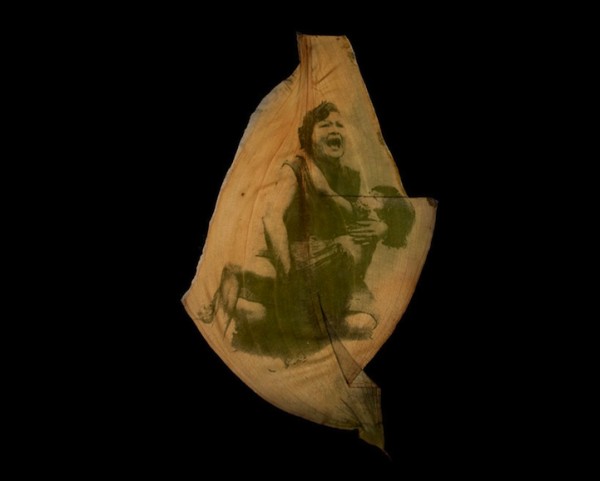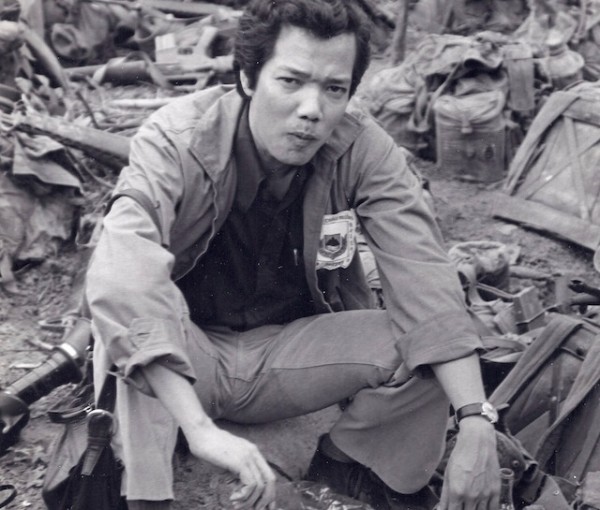Compelling stories and powerful images allow us to remember or learn our histories. Here are three different narratives of the Vietnamese diaspora experience, expressed through three different mediums: a memoir essay, chlorophyl prints, and a novel.
My Living, Yet Lost, Father: The Final Weeks Of South Vietnam Changed Everything Between Us, by Kyanh Tonnu (excerpt from Zócalo Public Square)
Tonnu, a school teacher in Los Angeles, writes about his family’s experience of hearing the news about the fall of Saigon. The photo above is of his father in 1974.
In the days following the end of the war, I stopped going to school, and the grief in our home gave way to frenzied activity. My parents were calling, waiting for news of family members. Many of them left amidst the now infamous scene at Tan San Nhut airport and the U.S. embassy: hordes of people with the whole of their lives in plastic bags, pushing and shoving their way onto airplanes and whirring Chinooks. It was a time of human accounting. Who left? Who stayed behind? Who made it? Who died?
For us, departure was imminent as well. The Singapore government, anticipating the large numbers of refugees who would seek asylum, abruptly stopped recognizing South Vietnamese passports. We were without a nationality. Reuters offered my father a position in its Hong Kong bureau, but he didn’t take it. Instead, he left Reuters, and, in June of that year, we left for Paris, moving into a beautiful and cold apartment in a lonely part of the 16th arrondissement.
Read the whole essay here.
Immortality, The Remnants of the Vietnam and American War, by Binh Danh (exceprt from his website)

The artist, Danh, was born into a family of war refugees displaced from Vietnam to San Jose in 1980. He explores the transmigratory influences on his work:
In my work, photosynthesis is used to record images onto leaves using only chlorophyll and light: the life source of plants and, consequently the Earth… This process deals with the idea of elemental transmigration: the decomposition and composition of matter into other forms. The images of war are part of the leaves, and live inside and outside of them. The leaves express the continuum of war. They contain the residue of the Vietnam War: bombs, blood, sweat, tears, and metals. The dead have been incorporated into the landscape of Vietnam during the cycles of birth, life, and death; through the recycling and transformation of materials, and the creation of new materials. As matter is neither created nor destroyed, but only transformed, the remnants of the Vietnam and American War live on forever in the Vietnamese landscape.
To see more, click here.
The Gangster We Are All Looking For, by Le Thi Diem Thuy (excerpt from Powell’s Books)
The author, Le Thi Diem Thuy, was born in Phan Thiet, South Vietnam, and left Vietnam on a boat with her father in 1978. The novel reflects her experiences:
Linda Vista, with its rows of yellow houses, is where we eventually washed to shore. Before Linda Vista, we lived in the Green Apartment on Thirtieth and Adams, in Normal Heights. Before the Green Apartment, we lived in the Red Apartment on Forty-ninth and Orange, in East San Diego. Before the Red Apartment we weren’t a family like we are a family now. We were in separate places, waiting for each other. Ma was standing on a beach in Vietnam while Ba and I were in California with four men who had escaped with us on the same boat.
Ba and I were connected to the four uncles, not by blood but by water. The six of us had stepped into the South China Sea together. Along with other people from our village, we floated across the sea, first in the hold of the fishing boat, and then in the hold of a U.S. Navy ship. At the refugee camp in Singapore, we slept on beds side by side and when our papers were processed and stamped, we packed our few possessions and left the camp together. We entered the revolving doors of airports and boarded plane after plane. We were lifted high over the Pacific Ocean. Holding on to one another, we moved through clouds, ghost vapors, time zones. On the other side, we walked through a light rain and climbed into a car together. We were carried through unfamiliar brightly lit streets, and delivered to the sidewalk in front of a darkened house whose door we entered, after climbing five uneven steps together in what had become pouring rain.
I know, I was captivated too. If I could link you to an illegal .pdf copy of the book, I would. But no luck. I need to go borrow this book from the public library…
(Photo credit: Kyanh Tonnu & Binh Danh) [h/t: Koji]









